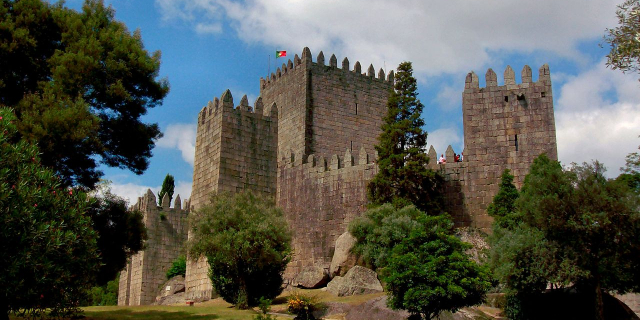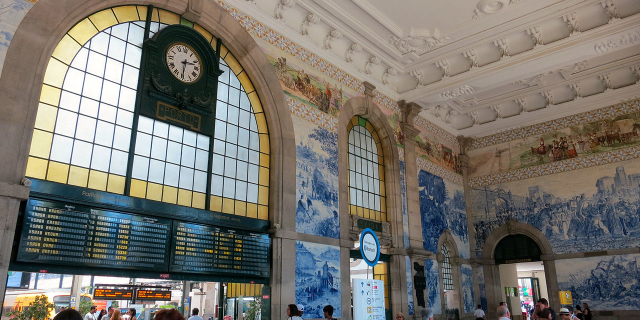Guimarães
Guimarães (Portuguese pronunciation: [ɡimɐˈɾɐ̃jʃ] ) is a city and municipality located in northern Portugal, in the district of Braga. Its historic town centre has been listed as a UNESCO World Heritage Site since 2001, in recognition for being an "exceptionally well-preserved and authentic example of the evolution of a medieval settlement into a modern town" in Europe. The Nicolinas are the city's main festivities.
Guimarães is also referred as the capital of the Ave Subregion (one of the most industrialised subregions in the country), and it’s located in the historical Minho Province. The city has a population of 152,309 inhabitants according to the most recent data of 2019 in an area of 240.95 square kilometres (93.03 sq mi). The current Mayor is Domingos Bragança, of the Socialist Party. Guimar...Read more
Guimarães (Portuguese pronunciation: [ɡimɐˈɾɐ̃jʃ] ) is a city and municipality located in northern Portugal, in the district of Braga. Its historic town centre has been listed as a UNESCO World Heritage Site since 2001, in recognition for being an "exceptionally well-preserved and authentic example of the evolution of a medieval settlement into a modern town" in Europe. The Nicolinas are the city's main festivities.
Guimarães is also referred as the capital of the Ave Subregion (one of the most industrialised subregions in the country), and it’s located in the historical Minho Province. The city has a population of 152,309 inhabitants according to the most recent data of 2019 in an area of 240.95 square kilometres (93.03 sq mi). The current Mayor is Domingos Bragança, of the Socialist Party. Guimarães, along with Maribor, Slovenia, was the European Capital of Culture in 2012.
The city was settled in the 9th century, at which time it was called Vimaranes. This name might have had its origin in the warrior Vímara Peres, who chose this area as the main government seat for the County of Portugal which he conquered for the Kingdom of Galicia. Guimarães has a significant historical importance due to the role it played in the foundation of Portugal. The city is commonly referred to as the "birthplace of Portugal" or "the cradle city" (Cidade Berço in Portuguese) because it was in Guimarães that Portugal's first King, Afonso Henriques was born, and also due to the fact that the Battle of São Mamede – which is considered the seminal event for the foundation of the Kingdom of Portugal – was fought in the vicinity of the city. It was declared the most beautiful small city in Europe by the Condé Nast Traveler magazine in 2022.
 The Oliveira square, in the historical center of Guimarães, with the Padrão do Salado on the left
The Oliveira square, in the historical center of Guimarães, with the Padrão do Salado on the left Pombaline buildings in the Toural, Guimarães, Portugal
Pombaline buildings in the Toural, Guimarães, PortugalThe History of Guimarães is associated with the foundation and identity of the Portuguese nationality. Guimarães, as well as other settlements, precedes the foundation of Portugal and because of its role in the foundation of the country it is known as the "cradle of the Portuguese nationality". In 1128, major political and military events that would lead to the independence and the birth of a new nation took place in Guimarães. For this reason, in one of the old towers of the city's old wall it is written "Aqui nasceu Portugal" (Portugal was born here).
Ancient historyAccording to archeological findings in Citânia (Castro) of Briteiros and Sabroso and Penha's archeologic site, the area in which Guimarães is located has had permanent settlements since the late Chalcolithic period.
There is also evidence of Roman occupation, and a stone dedicated to the Roman emperor Trajan found in Caldas das Taipas suggests that this was already a spa town in Roman times.[1]
Foundation Statue of Mumadona Dias, in front of the city court
Statue of Mumadona Dias, in front of the city courtFollowing the Reconquista policy promoted by the Kingdom of Galicia in the 9th century, the medieval foundations of the actual city have roots in the 10th century. At this point, the Countess Mumadona Dias, erected a monastery in her property of Vimaranes, which led to the settlement of people in the area known as "vila baixa" (downtown). At the same time, she ordered the construction of a castle on the hill area which became known as "vila alta" (uptown), to defend the settlement. To connect these to other areas, the Rua de Santa Maria was built.
The monastery became the "Real Colegiada" (Royal Collegiate church) and throughout time acquired importance due to the privileges and donations given to it by nobles and kings and it became a famous pilgrimage site.
Henry, Count of Portugal approved the first national foral possibly in 1096 (but not confirmed). The foral proves the growing importance of the village of Guimarães at that time, which was chosen as the capital of the County of Portugal.
On 24 June 1128, the "Batalha de São Mamede" (Battle of São Mamede) took place in Guimarães.
Middle AgesDuring the reign of king Denis, as the town was expanding, it was partially surrounded by a defensive wall. Meanwhile, mendicant orders settled in Guimarães and helped to mold the shape of the emerging city. Later, during the reign of John I, the wall was torn down and the two parts of the city (uptown and downtown) were finally united and the city began to expand outside its old walls.
The construction of St. Peter's Basilica began in 1737, and became a minor basilica in 1751, with formal completion of the work between 1883 and 1884.
Modern historyUntil the 19th century the structure of the city did not suffer many transformations besides the construction of a few more churches, convents and palaces. It was by the ending of the 19th century that new urbanistic ideas of hygiene and symmetry that the village, that was promoted to city by the Queen Maria II on 23 June 1853 had its greatest changes.
The complete demolition of the city walls was authorized and the creation of many streets and avenues could start at that point. The controlled process of urbanization permitted the conservation of the city's magnificent historical center.



































Add new comment